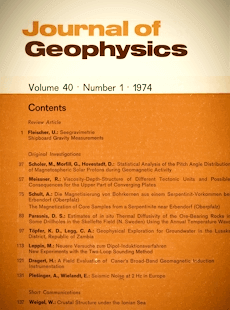Electromagnetic reflections in salt deposits
Article Sidebar
Published:
Nov 28, 1974
Keywords:
Reflection Method (Electromagnetic),
Salt Deposits
Volumes

Vols. 1-18 (1924-1944), ISSN 0044-2801
Main Article Content
R. Thierbach
Lower Saxony State Office for Soil Research, Hannover Germany
Abstract
The generation of short high frequency electromagnetic pulses in the VHF-band opens up the possibility of applying electromagnetic reflection methods in the geophysical prospecting of dry formations, with high resolution and also over small distances. A method has been developed using a spark transmitter for locating boundaries in salt deposits The transmitter, which is technically very simple in contrast to other pulse transmitters, produces short powerful pulses. The results to date show good quality reflections of salt clay and anhydrite.
 ARK: https://n2t.net/ark:/88439/y082408
ARK: https://n2t.net/ark:/88439/y082408
Permalink: https://geophysicsjournal.com/article/188
Article Details
How to Cite
Section
References
Fritsch, V.: Die Ausbreitung hochfrequenter Hertzscher Felder in Kalilagerstatten. Geofis. Pura Appl. 12, 23-52, 1948
Holser, W. T., Brown, R.J.S., Roberts, F.A., Fredriksson, O.A., Unterberger, R.R.: Radar logging of a salt dome. Geophysics 3 7, 889-906, 1972
Jung, H.: Die Bedeutung der Hochfrequenz fur den Bergbau. Elektrotechnik 4, 145-148, 1950
Morey, R.M., Nashua,N.H.: German Patent P 2264037.5, "Geophysikalische Meseinrichtung", 1972
Nickel, H., Thierbach, R., Durbaum, H.J.: On developments and applications in seismics and high frequency electromagnetics for the solution of some problems in salt mines. Read at 43rd meeting of the SEG, Mexico City, 1973
Thierbach, R., Mayrhofer, H.: Application for a German Patent P 2360878.5 "Electromagnetisches Reflexionsmesverfahren zum Orten von stofflichen Diskontinuitaten in Lagerstatten", 1973
Unterberger, R.R., Hluchanek, J.A.: Mapping a Salt Dome Top by Electromagnetic Waves from Inside the Salt. Read at 43rd meeting of the SEG, Mexico City, 1973
Holser, W. T., Brown, R.J.S., Roberts, F.A., Fredriksson, O.A., Unterberger, R.R.: Radar logging of a salt dome. Geophysics 3 7, 889-906, 1972
Jung, H.: Die Bedeutung der Hochfrequenz fur den Bergbau. Elektrotechnik 4, 145-148, 1950
Morey, R.M., Nashua,N.H.: German Patent P 2264037.5, "Geophysikalische Meseinrichtung", 1972
Nickel, H., Thierbach, R., Durbaum, H.J.: On developments and applications in seismics and high frequency electromagnetics for the solution of some problems in salt mines. Read at 43rd meeting of the SEG, Mexico City, 1973
Thierbach, R., Mayrhofer, H.: Application for a German Patent P 2360878.5 "Electromagnetisches Reflexionsmesverfahren zum Orten von stofflichen Diskontinuitaten in Lagerstatten", 1973
Unterberger, R.R., Hluchanek, J.A.: Mapping a Salt Dome Top by Electromagnetic Waves from Inside the Salt. Read at 43rd meeting of the SEG, Mexico City, 1973











